.gif)
Kriván (peak)
Encyclopedia
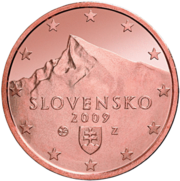
High Tatras
High Tatras or High Tatra are a mountain range on the borders between Slovakia and Poland. They are a part of the Tatra Mountains...
, Slovakia
Slovakia
The Slovak Republic is a landlocked state in Central Europe. It has a population of over five million and an area of about . Slovakia is bordered by the Czech Republic and Austria to the west, Poland to the north, Ukraine to the east and Hungary to the south...
, that dominates the upper part of the former Liptov
Liptov
Liptó is the name of a historic administrative county of the Kingdom of Hungary. Its territory is presently in northern Slovakia.-Geography:...
County. Multiple surveys among nature lovers have ranked it as the country's most beautiful peak. Readily accessible along maintained marked trails and with the exceptional vistas afforded from its summit, it is the hikers' favorite mountain in the western part of the High Tatras. Kriváň has also been a major symbol in Slovak ethnic and national activism for the past two centuries. It has been referenced in works of art from 19th-century literature, through paintings, film documentaries, to a Polish rock track. A country-wide vote in 2005 selected it to be one of the images on Slovakia's euro coins
Slovak euro coins
Slovak euro coins feature three separate designs for the three series of coins. Slovakia has been a member of the European Union since May 2004, and is a member of the European Economic and Monetary Union...
.
Name
The name Kriváň, first recorded as Kriwan in 1639, is derived from the root kriv- meaning "bent" or "crooked" (the words do not have the secondary negative meanings of their English equivalents). It reflects the angled appearance of its shape when viewed from the west and south, characterized in the work from 1639 as an "oxtail" (cauda bubula in the Latin original). The Slovak name is used in other languages including in Polish, rather than its potential PolonizedPolonization
Polonization was the acquisition or imposition of elements of Polish culture, in particular, Polish language, as experienced in some historic periods by non-Polish populations of territories controlled or substantially influenced by Poland...
version (Krzywań), except occasionally in Podhale
Podhale
The Podhale is Poland's most southern region, sometimes referred to as the "Polish highlands". The Podhale is located in the foothills of the Tatra range of the Carpathian mountains, and is characterized by a rich tradition of folklore that is much romanticized in the Polish patriotic imagination...
in the immediate vicinity of the Tatras.
Two adjacent peaks in the nearby Malá Fatra range carry the same name, and so does the village of Kriváň
Kriván (village)
Kriváň is a village and municipality in Detva District, in the Banská Bystrica Region of central Slovakia.-External links:*http://www.statistics.sk/mosmis/eng/run.html...
farther away in southern Slovakia.
Elevation
Based merely on visual observation, Kriváň competed for the status of the highest mountain in the High TatrasHigh Tatras
High Tatras or High Tatra are a mountain range on the borders between Slovakia and Poland. They are a part of the Tatra Mountains...
with Lomnický štít
Lomnický štít
Lomnický štít is one of the highest and most visited mountain peaks in the High Tatras mountains of Slovakia. Connected by cable car to Tatranská Lomnica, its summit is 2634 metres above sea level, making it the second highest peak in the High Tatras after Gerlachovský štít.The first ascent was...
, which dominates the view from the east, until 1793 when the latter was accurately identified as the higher of the two (but wrongly as the highest peak in the mountain range, an error corrected by Ludwig Greiner
Ludwig Greiner
Ludwig Greiner was an influential 19th-century forest and lumber industry management expert who improved the effectiveness of woodland valuation methods in the Austrian Empire and trained a whole new generation of foresters in a comprehensive approach to the management of natural resources...
in 1837):

[Kriváň] is generally said to be the highest of all the Alps in the Carpathian chain; but this opinion is not supposed to be founded upon any measurement.
The relative elevations of the two mountains were determined by the Scottish physician Robert Townson, who ascended both peaks in August 1793 and also made an early recorded comment on Kriváň's aesthetic appeal:
The weather was very fine, and the Krivan, having got in the night a cap of snow, looked sublime. [...] 1888 yards above the village of Vasetz[ VažecVažecVažec is a village and municipality in Liptovský Mikuláš District in the Žilina Region of northern Slovakia, at the foot of Kriváň, Slovakia's symbolic and often considered most beautiful mountain. It is a great place.-History:...] ; the Krivan is therefore something lower than the Lomnitz Peak[ Lomnický štítLomnický štítLomnický štít is one of the highest and most visited mountain peaks in the High Tatras mountains of Slovakia. Connected by cable car to Tatranská Lomnica, its summit is 2634 metres above sea level, making it the second highest peak in the High Tatras after Gerlachovský štít.The first ascent was...].
The exact elevation of Kriváň is currently recognized as 2,494.7 m (8,184.7 ft.)
Kriváň is believed to have the greatest prominence in the whole Tatras, as it rises from the bottom of the Kôprova valley or from Tri Studničky up to 1400 metres.
Before 1800
Records of explorations by miners in the Kriváň massif date to the first half of the 15th century. Their presence increased during the gold rush of the 16th century. Although they may not have been the first to do so, it is probable that some of the miners reached the top of Kriváň; remnants of their shacks have survived below Priehyba Ridge at the elevation of about 2,000 m (6,560 ft.) through the present, and the highest, long abandoned, Terézia Shaft is merely about 60 m (200 ft.) below the summit. The commercial exploitation of the meager deposits discovered at Kriváň proved to be barely viable. It was abandoned in the 18th century.The Scottish doctor Townson who ascended it in 1793 provided some evidence that Kriváň was already a recognized occasional destination for tourists in the second half of the 18th century. His guide from Važec
Važec
Važec is a village and municipality in Liptovský Mikuláš District in the Žilina Region of northern Slovakia, at the foot of Kriváň, Slovakia's symbolic and often considered most beautiful mountain. It is a great place.-History:...
had been to the top several times before and Townson saw him collect small coins from under a summit stone where hikers would leave them for luck. The first recorded ascent of Kriváň was by the Lutheran Pastor Andreas Jonas Czirbes from Spišská Nová Ves on 4 August 1773.
Celebrities
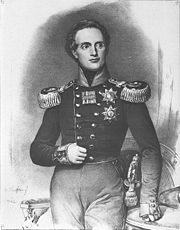
Very Important Person
A Very Important Person, or VIP is a person who is accorded special privileges due to his or her status or importance.Examples include celebrities, heads of state/heads of government, major employers, high rollers, politicians, high-level corporate officers, wealthy individuals, or any other...
actually to reach the summit was the 43-year-old King Frederick Augustus II of Saxony
Frederick Augustus II of Saxony
Frederick Augustus II |Tyrol]], 9 August 1854) was King of Saxony and a member of the House of Wettin.He was the eldest son of Maximilian, Prince of Saxony --younger son of the Elector Frederick Christian of Saxony—by his...
in 1840. The plaque placed at the top to commemorate the first monarch who stood there was gradually destroyed by activists in the 1850s-1860s, who would have wished the inscription to include a comment in Slovak and who objected to where the inscription spoke of the Hungarian (ethnic) nation in reference to all the subjects of the Kingdom of Hungary.
Lower nobleman Gašpar Fejérpataky Belopotocký, an influential publisher based at Liptovský Mikuláš
Liptovský Mikuláš
Liptovský Mikuláš is a town in northern Slovakia, on the Váh River. It lies in the Liptov region, in Liptov Basin near the Low Tatra and Tatra mountains...
merely 20 miles from Kriváň, and his six friends climbed to the top of Kriváň on 24 Sept. 1835, which he described in the literary journal Hronka in 1837. The account may have stimulated its readers who lived farther away to follow their steps.
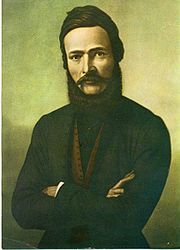
Ludovít Štúr
Ľudovít Štúr , known in his era as Ludevít Velislav Štúr, was the leader of the Slovak national revival in the 19th century, the author of the Slovak language standard eventually leading to the contemporary Slovak literary language...
, then a 25-year old teaching assistant of Slovak at the Bratislava Lutheran Lýceum
Lyceum
The lyceum is a category of educational institution defined within the education system of many countries, mainly in Europe. The definition varies between countries; usually it is a type of secondary school.-History:...
(a preparatory high school and college). In the summer of 1841 he traveled through the Slovak counties with his private Greek student Prince Aristarchos and stopped at Michal Miloslav Hodža's parish at Liptovský Mikuláš
Liptovský Mikuláš
Liptovský Mikuláš is a town in northern Slovakia, on the Váh River. It lies in the Liptov region, in Liptov Basin near the Low Tatra and Tatra mountains...
, whose younger brother Juraj was Štúr's student at the lýceum. Štúr and a group of locals, Fejérpataky Belopotocký among them, hiked to the top of Kriváň on 16 August, its first recorded ascent that included women.
National excursions
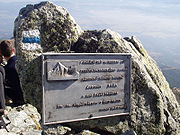
Poprad
Poprad is a city in northern Slovakia at the foot of the High Tatra Mountains famous for its picturesque historic centre and as a holiday resort. It is the biggest town of the Spiš region and the tenth largest city in Slovakia with a population of approximately 55,000.The Poprad-Tatry Airport is...
in 1955 in order to commemorate the anniversary of the uprising of 1944
Slovak National Uprising
The Slovak National Uprising or 1944 Uprising was an armed insurrection organized by the Slovak resistance movement during World War II. It was launched on August 29 1944 from Banská Bystrica in an attempt to overthrow the collaborationist Slovak State of Jozef Tiso...
. The attendance reached 480 people in 1981. They have continued with a broader national designation through the present. The National Ascent of Kriváň (Národný výstup na Kriváň) is an annual two-day event on the third weekend in August organized by the Slovak Tourist Club, Matica slovenská
Matica slovenská
The Matica slovenská Mother) is Slovakia's public-law cultural and scientific institution focusing on topics around the Slovak nation. It is based in the city of Martin...
, and the towns of Vysoké Tatry
Vysoké Tatry (town)
Vysoké Tatry , informally Mesto Vysoké Tatry , is a town at the feet of the Slovak part of High Tatras in Slovakia including all the major resorts in that region...
and Liptovský Mikuláš
Liptovský Mikuláš
Liptovský Mikuláš is a town in northern Slovakia, on the Váh River. It lies in the Liptov region, in Liptov Basin near the Low Tatra and Tatra mountains...
. The number of persons allowed to ascend the summit on each of the event days is limited to 300.
Access
The three marked hiking routes to Kriváň start at different locations, but all ultimately converge at the elevation of about 2,145 m (7,035 ft.) for the final ca. 350-meter (1,150-foot) steep, rocky ascent to the summit − the only segment where both hands may be needed to maintain balance in places.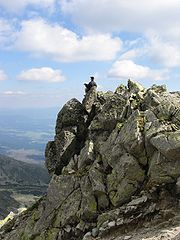
- The trailhead of the blue-marked trail is on the road between Štrbské PlesoŠtrbské PlesoŠtrbské Pleso with its large glacial mountain lake is a favorite ski, tourist, and health resort in the High Tatras, Slovakia. With extensive parking facilities and a stop on the Tatra trolley and rack railway, it is a starting point for a host of popular hikes including to Kriváň and...
and PribylinaPribylinaPribylina is a village in Liptovský Mikuláš District in the Žilina Region of northern Slovakia, at the foot of Kriváň, Slovakia's symbolic and often considered most beautiful mountain.-Geography:...
, the color stays the same to the summit; elevation gain ca. 1,300 m (4,265 ft.). - The green-marked trailhead is on the same road closer to PribylinaPribylinaPribylina is a village in Liptovský Mikuláš District in the Žilina Region of northern Slovakia, at the foot of Kriváň, Slovakia's symbolic and often considered most beautiful mountain.-Geography:...
at Tri Studničky, the green trail links with the blue trail below the summit; elevation gain ca. 1,360 m (4,460 ft.). - Hikers starting from Štrbské PlesoŠtrbské PlesoŠtrbské Pleso with its large glacial mountain lake is a favorite ski, tourist, and health resort in the High Tatras, Slovakia. With extensive parking facilities and a stop on the Tatra trolley and rack railway, it is a starting point for a host of popular hikes including to Kriváň and...
follow the red-marked trail towards Podbanské only to its intersection with the blue-marked trail at Jamské pleso from where they follow the blue trail to the summit; elevation gain ca. 1,150 m (3,770 ft.).
The historical winding road built by miners for horse-drawn ore carts and used by hikers in the past, including the participants of the revered 1841 excursion, is between the green and blue trails and links up with the green trail above the timberline below Priehyba Ridge. The road is not marked, the Tatra National Park
Tatra National Park, Slovakia
Tatra National Park is one of the nine national parks in Slovakia. It is situated in North Central Slovakia in the Tatra Mountains. The Tatra National Park protects the area of the Western Tatras and the Eastern Tatras .The National Park covers an area of 738 km² , and the buffer zone around the...
management decreed it off limits. It is partly obscured by shrubby mountain pines
Mountain Pine
Pinus mugo, the Mountain Pine or Mugo Pine, is a high-altitude European pine, found in the Pyrenees, Alps, Erzgebirge, Carpathians, northern Apennines and Balkan Peninsula mountains from 1,000 m to 2,200 m, occasionally as low as 200 m in the north of the range in Germany and Poland, and as high...
at higher elevations.
Kriváň has been favored by those appreciative of its aesthetic and historical allure, as well as by those who seek vistas from the top. Polls of nature lovers at large as well as of connoisseurs have consistently rated it as Slovakia's most beautiful mountain. The 360-degree view from the top is among the best in Slovakia with the scenery ranging from the populated valleys of upper Liptov
Liptov
Liptó is the name of a historic administrative county of the Kingdom of Hungary. Its territory is presently in northern Slovakia.-Geography:...
, Spiš
Spiš
Spiš is a region in north-eastern Slovakia, with a very small area in south-eastern Poland. Spiš is an informal designation of the territory , but it is also the name of one the 21 official tourism regions of Slovakia...
, and distant parts of Podhale
Podhale
The Podhale is Poland's most southern region, sometimes referred to as the "Polish highlands". The Podhale is located in the foothills of the Tatra range of the Carpathian mountains, and is characterized by a rich tradition of folklore that is much romanticized in the Polish patriotic imagination...
, to the rugged drops of its north face, and many of the notable peaks of the Tatras including Giewont
Giewont
Giewont is a mountain massif in the Tatra Mountains of Poland, and is 1895 metres AMSL at its highest.It comprises three peaks :* Small Giewont -...
over Zakopane
Zakopane
Zakopane , is a town in southern Poland. It lies in the southern part of the Podhale region at the foot of the Tatra Mountains. From 1975 to 1998 it was in of Nowy Sącz Province, but since 1999 it has been in Lesser Poland Province. It had a population of about 28,000 as of 2004. Zakopane is a...
, Rysy
Rysy
Rysy is a mountain in the crest of the High Tatras, lying on the border between Poland and Slovakia. Rysy has three peaks: the middle at ; the north-western at ; and the south-eastern at...
, Lomnický štít
Lomnický štít
Lomnický štít is one of the highest and most visited mountain peaks in the High Tatras mountains of Slovakia. Connected by cable car to Tatranská Lomnica, its summit is 2634 metres above sea level, making it the second highest peak in the High Tatras after Gerlachovský štít.The first ascent was...
, and Gerlach, the highest peak of the Carpathians. The panorama is framed by the Western
Western Tatras
The Western Tatras are mountains in the Tatras, part of the Carpathian Mountains, located on the Polish-Slovak borders. The mountains border the High Tatras in the east, Podtatranská kotlina in the south, Choč Mountains in the west and Rów Podtatrzański in the north...
and Low Tatras, and by mountain ranges beyond them in good visibility.

Early development
The mountain is mentioned by Nikolai GogolNikolai Gogol
Nikolai Vasilievich Gogol was a Ukrainian-born Russian dramatist and novelist.Considered by his contemporaries one of the preeminent figures of the natural school of Russian literary realism, later critics have found in Gogol's work a fundamentally romantic sensibility, with strains of Surrealism...
as the abode of two Cossack
Cossack
Cossacks are a group of predominantly East Slavic people who originally were members of democratic, semi-military communities in what is today Ukraine and Southern Russia inhabiting sparsely populated areas and islands in the lower Dnieper and Don basins and who played an important role in the...
brothers, Ivan and Petro, in his short story 'The Terrible Vengeance
A Terrible Vengeance
A Terrible Vengeance is a Gothic horror story by Nikolai Gogol. It was published in the second volume of his first short story collection, Evenings on a Farm Near Dikanka, in 1832, and it was probably written in late Summer 1831....
', written in 1832.
After lower nobleman Gašpar Fejérpataky Belopotocký (1794-1874) published an account of his 1835 ascent of Kriváň in the literary journal Hronka in 1837, its editor-in-chief Karol Kuzmány (1806-1866) wrote the novella
Novella
A novella is a written, fictional, prose narrative usually longer than a novelette but shorter than a novel. The Science Fiction and Fantasy Writers of America Nebula Awards for science fiction define the novella as having a word count between 17,500 and 40,000...
Ladislav (1838), whose title character, taking the long way home from Italy via Germany and the Polish Podhale
Podhale
The Podhale is Poland's most southern region, sometimes referred to as the "Polish highlands". The Podhale is located in the foothills of the Tatra range of the Carpathian mountains, and is characterized by a rich tradition of folklore that is much romanticized in the Polish patriotic imagination...
, hikes to the summit of Kriváň where he and his friends talk about brotherhood among the Slavs, sing ethnically-nationally arousing songs, and imbibe Tokaj wine. Both works may have motivated the hike by Ľudovít Štúr
Ludovít Štúr
Ľudovít Štúr , known in his era as Ludevít Velislav Štúr, was the leader of the Slovak national revival in the 19th century, the author of the Slovak language standard eventually leading to the contemporary Slovak literary language...
and friends in 1841 that inspired him to write two poems published in 1842. Romantic poets
Romantic poetry
Romanticism, a philosophical, literary, artistic and cultural era which began in the mid/late-1700s as a reaction against the prevailing Enlightenment ideals of the day , also influenced poetry...
soon became fervent admirers of the eye-catching mountain. Eugen V. Šparnensis (1827-after 1853) called Kriváň a marker of his homeland, the Slovaks were "Kriváň's children" for Janko Kráľ
Janko Král
Janko Kráľ Janko Kráľ Janko Kráľ (24 April 1822 in Liptovský Svätý Mikuláš (now Liptovský Mikuláš, Slovakia) - 23 May 1876 in Zlaté Moravce was one of the most significant and most radical Slovak romantic poets of the Ľudovít Štúr generation and a national activist....
, Samo Chalupka's
Samo Chalupka
Samo Chalupka was a Slovak romantic poet.- Life :Samo Chalupka was a younger brother of Ján Chalupka, another Slovak writer. Samo studied at the Evangelical Lutheran Lyceum in Bratislava and also in Vienna. He studied theology and philosophy...
poem saw the mountain as a symbol of their place among the nations.
Popular culture
The significance the intellectuals began to ascribe to Kriváň and its images they created were gradually adopted by popular culture. An early instance is the poem Oh, Below Kriváň (Hej, pod Kriváňom; originally: Hej, pod Muráňom) by Samuel Tomášik (1813-1887), which came to be seen as an anonymous folk song and is sometimes featured as such on folk albums. Likewise, the Polish poem Kriváň, High Kriváň! (Krywaniu, Krywaniu wysoki!) by Kazimierz Przerwa-TetmajerKazimierz Przerwa-Tetmajer
Kazimierz Przerwa-Tetmajer was a Polish poet, novelist, playwright, journalist and writer. He was a member of the Young Poland movement.-Life:...
was labeled as a folk song and the author of the verses was not credited when its rock version by Skaldowie
Skaldowie
Skaldowie, a Cracow, Poland, rock group, was particularly popular from the 1960s to the 1980s. With their musical training and proximity to the folklore-rich area of Podhale, many of their tracks were a fusion of rock, folk, and classical music....
was released in 1972.
Visual arts
The short film Up the North Face of Kriváň (Severnou stenou na Kriváň; 1947) directed by Karol Skřipský with original music by Šimon Jurovský documented the first winter ascent of the Kriváň North Face, which, unlike the southern slopes of the massif, requires technical climbing. The mountain featured as an attractive backdrop in several films including Native Country (Rodná zem; dir. Josef Mach, 1954). It has appeared in numerous paintings, including by Ján Hála (1946), Miloš Alexander BazovskýMiloš Alexander Bazovský
Miloš Alexander Bazovský was an eminent Slovak painter, often ranked among the most prominent figures of 20th century art from Slovakia.-Further reading:*Cincík, J.: Miloš A. Bazovský...
(1956), Andrej Doboš (1967), and Ladislav Čemický (1979). The role of Kriváň in popular awareness and high culture was highlighted when a country-wide vote in 2005 selected it to be one of the images on Slovakia's euro coins
Slovak euro coins
Slovak euro coins feature three separate designs for the three series of coins. Slovakia has been a member of the European Union since May 2004, and is a member of the European Economic and Monetary Union...
.

